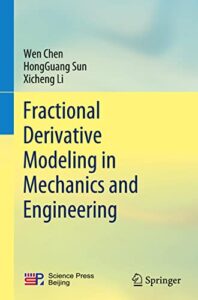| Book Name: | Fractional Derivative Modeling in Mechanics and Engineering |
| Category: | Mechanical Books |
| Language: | English |
| Format: | |
| Free Download: | Available |
Free Download Fractional Derivative Modeling in Mechanics and Engineering PDF Book

Book Description:
This textbook highlights the theory of fractional calculus and its wide applications in mechanics and engineering. It details the research findings in using fractional calculus methods for modeling and numerical simulation of complex mechanical behavior. It covers the mathematical basis of fractional calculus, the relationship between fractal and fractional calculus, unconventional statistics and anomalous diffusion, typical applications of fractional calculus, and the numerical solution of the fractional differential equation. It also includes the latest findings, such as variable order derivative, distributed order derivative, and its applications. Unlike other textbooks on this subject, the book avoids lengthy mathematical demonstrations and presents the theories in close connection to the applications in an easily readable manner. This textbook is intended for students, researchers, and professionals in applied physics, engineering mechanics, and applied mathematics. It is also of high reference value for those in environmental mechanics, geotechnical mechanics, biomechanics, and rheology.
Table of contents :
Preface
Contents
1 Introduction
1.1 History of Fractional Calculus
1.2 Geometric and Physical Interpretation of Fractional Derivative Equation
1.2.1 Frequency-Dependent Energy Dissipation Process
1.2.2 Fractal Description and Power-Law Phenomena
1.2.3 Anomalous Diffusion
1.2.4 Constitutive Relation of Complex Viscoelastic Material
1.2.5 Fractional Schrodinger Equation
1.3 Application in Science and Engineering
1.4 Anomalous Diffusion Modeling in Environmental Mechanics
1.5 Constitutive Relation of Viscoelasticity
1.6 Biomedical Science
1.7 System Control
References
2 Mathematical Foundation of Fractional Calculus
2.1 Definition of Fractional Calculus
2.1.1 Introduction of Fractional Calculus Definition
2.1.2 Riemann–Liouville Definition
2.1.3 Caputo’s Definition
2.1.4 Grünwald–Letnikov Definition
2.1.5 Riesz Definition of the Spatial Fractional Laplace Operator
2.2 Properties of Fractional Calculus
2.2.1 Some Properties of Riemann–Liouville Operator
2.2.2 Fractional Derivative of Some Functions
2.2.3 The Relationships of Different Definitions
2.3 Fourier and Laplace Transforms of the Fractional Calculus
2.3.1 Fourier Transform of the Fractional Calculus
2.3.2 Laplace Transform of the Fractional Calculus
2.4 Analytical Solution of Fractional-Order Equations [10]
2.4.1 Algorithms of Integral Transform
2.4.2 Green’s Function [2]
2.4.3 Adomian Decomposition Method (ADM)
2.4.4 Homotopy Function Method
2.4.5 Other Iteration Methods
2.5 Questions and Discussions
2.5.1 Fractal Derivative, Positive Fractional Derivative, Variable-Order Derivative and Random-Order Derivative
2.5.2 Discussions on the Spatial Fractional Derivative
2.5.3 Discussions on the Geometric and Physical Interpretation of Fractional Calculus
References
3 Fractal and Fractional Calculus
3.1 Fractal Introduction and Application
3.1.1 Simple Fractal Geometry
3.1.2 The Basic Characteristics of the Fractal
3.1.3 The Measurement of Fractal Dimension
3.1.4 The Application of Fractal
3.2 The Relationship Between Fractional Calculus and Fractal
3.2.1 The Fractional Derivative of a Class of Fractal Function
3.2.2 The Relationship Between the Dimension of Fractal Function and the Order of Fractional Calculus
3.2.3 The Application of Fractional Calculus in the Description of Constitutive Relation for Fractal Media
3.2.4 The Kinetic Equations of Fractal Media
References
4 Fractional Diffusion Model, Anomalous Statistics and Random Process
4.1 The Fractional Derivative Anomalous Diffusion Equation
4.1.1 Statistical Description of Anomalous Diffusion Problems
4.1.2 Fractional Anomalous Diffusion Equation
4.1.3 Fractional Fick’s Law [7]
4.1.4 Fractional Derivative Advection–Diffusion Equation
4.2 Statistical Model of the Acceleration Distribution of Turbulence Particle
4.2.1 Existing Models
4.2.2 Power-Stretched Gaussian Distribution Model
4.2.3 Comparisons and Discussions
4.3 Lévy Stable Distributions
4.3.1 General Expression of Lévy Stable Distributions
4.3.2 Lévy Stable Distributions with X ≥ 0 [41]
4.3.3 Stable Distributions
4.4 Stretched Gaussian Distribution
4.5 Tsallis Distribution
4.5.1 Tsallis Entropy
4.5.2 Tsallis Distribution
4.6 Ito Formula
4.6.1 Ito Integral
4.6.2 Ito Formula [47]
4.7 Random Walk Model
4.7.1 Discrete Random Walk Model
4.7.2 Continuous Random Walk Model (CTRW)
4.7.3 The Relationship Between Random Walk Model and Fractional Diffusion Equation
4.8 Discussion
4.8.1 The Applications of Statistical Distribution
4.8.2 The Relationship Between Statistical Distribution and Differential Equation
4.8.3 Lévy Stable Distributions and [0, 2] Power-Law Dependence of Acoustic Absorption on Frequency
References
5 Typical Applications of Fractional Differential Equations
5.1 Power-Law Phenomena and Non-Gradient Constitutive Relation
5.1.1 Power-Law Distribution Phenomena and Fractal Dimension
5.1.2 The Mechanism of Power-Law Distribution Phenomenon
5.1.3 Power-Law Phenomena and Non-gradient Constitutive Relation
5.2 Fractional Langevin Equation
5.2.1 Langevin Equation
5.2.2 Fractional Langevin Equation
5.3 The Complex Damped Vibration
5.3.1 The Model for Oscillator
5.3.2 Fractional Oscillator
5.4 Viscoelastic and Rheological Models
5.4.1 Component Model
5.4.2 Relaxation Modulus and Creep Compliance
5.4.3 Complex Relaxation Modulus and Complex Creep Compliance
5.4.4 Complex Relaxation Modulus and Complex Creep Compliance of Fractional Derivative Viscoelastic Models
5.4.5 Fractional Derivative Viscoelastic Models
5.4.6 Data Fitting and Analysis of Rheological Experiments of Soil
5.4.7 Exact Solution of the Fractional Derivative Model of Stokes Second Problem [56]
5.5 The Power-Law Frequency Dependent Acoustic Dissipation
5.5.1 Wave Propagation in Elastic Solids
5.5.2 Classical Models of Dissipative Wave in Viscoelastic Medium
5.5.3 Fractional Derivative Model of Wave in Viscoelastic Medium
5.5.4 Acoustic Wave in Fluids
5.5.5 Acoustic Absorption and Frequency Dependent Dissipation
5.5.6 Fractional Laplacian Equation of Power-Law Frequency-Dependent Dissipative Acoustic Wave
5.5.7 Fractional Derivative Models of Nonlinear Acoustic Wave
5.5.8 Fractional Derivative Seismic Wave Model
5.6 The Fractional Variational Principle of Mechanics
5.6.1 Variational Principle of Mechanics
5.6.2 Fractional Variational Principle
5.7 Fractional Schrödinger Equation
5.7.1 Wave-Particle Duality
5.7.2 Schrödinger Equation
5.7.3 The Physical Significance of the Wave Equation
5.7.4 Time Fractional-Order Schrödinger Equation
5.7.5 The Path Integral Principle and the Schrödinger Equation
5.7.6 Space Fractional Schrödinger Equation
5.7.7 Fractal Time–space Origin of Fractional Schrödinger Equation
5.8 Other Application Fields
5.8.1 Applications of Fractional Calculus in the Fracture Mechanics
5.8.2 Applications of Fractional Order Calculus in System Control [78, 121]
5.8.3 Inverse Problems on Fractional Derivative Models
5.9 Variable-Order, Distributed-Order and Random-Order Fractional Derivative Models with Its Applications
5.9.1 Variable-Order Fractional Derivative Modeling and Applications
5.9.2 Distributed-Order Fractional Derivative Modeling and Applications
5.9.3 Random-Order Fractional Derivative Modeling and Applications
5.10 Some Applications of Fractional Calculus in Biomechanics
5.10.1 Generalized Fractional Viscoelastic Dynamical Model of Otolith Organs
5.10.2 Generalized Fractional Dynamic Model of Semicircular Canal
5.10.3 Fractional Model of Human Cranial Bone
5.11 Some Applications of Fractional Calculus in the Modeling of Drug Release Process
5.11.1 Empirical Models
5.11.2 Mechanism Models
References
6 Numerical Methods for Fractional Differential Equations
6.1 Time-Fractional Differential Equations (TFDEs)
6.1.1 Finite Difference and Integral Equation Methods
6.1.2 Summaries and Comparisons of Solution Techniques for TFDEs
6.2 Space Fractional Differential Equations (SFDEs)
6.2.1 Numerical Methods for SFDEs
6.2.2 Comparison of Three Finite Difference Schemes for Space Fractional Diffusion Equations [60]
6.3 Open Issues of Numerical Methods for FDEs
6.4 Numerical Methods for Fractal Derivative Equations
6.5 Numerical Methods for Positive Fractional Derivative Equations
References
7 Current Development and Perspectives of Fractional Calculus
7.1 Summary and Discussion
7.1.1 Current Research and Application
7.1.2 Key Issues
7.2 Perspectives
Appendix A Special Functions
Gamma function
Beta Function
Dirac Delta Function
Mittag-Leffler Function
Wright Function
H-Fox Function
Appendix B Related Electronic Resources of Fractional Dynamics
Web Resources
Professional Journals
Open Source Codes
Key Words
The Relevant Pages of This Book
Download Fractional Derivative Modeling in Mechanics and Engineering PDF
Author(s): Wen Chen, HongGuang Sun, Xicheng Li
Publisher: Springer, Year: 2022
ISBN: 981168801X,9789811688010









![[PDF] Draw Buildings and Cities in 15 Minutes Draw Buildings and Cities in 15 Minutes pdf](https://www.freepdfbook.com/wp-content/uploads/2021/06/Draw-Buildings-and-Cities-in-15-Minutes-218x150.jpg)








![[PDF] Digital Image Processing An Algorithmic Introduction Using Java Digital Image Processing An Algorithmic Introduction Using Java](https://www.freepdfbook.com/wp-content/uploads/2022/06/Digital-Image-Processing-An-Algorithmic-Introduction-Using-Java.jpg)




![[PDF] 43 Years JEE ADVANCED + JEE MAIN Chapterwise & Topicwise Solved Papers 43 Years JEE ADVANCED (1978-2020) + JEE MAIN Chapterwise & Topicwise Solved Papers Physics PDF](https://www.freepdfbook.com/wp-content/uploads/2022/03/43-Years-JEE-ADVANCED-1978-2020.jpg)

![[PDF] Problems in Physical Chemistry for JEE (Main & Advanced) Problems in Physical Chemistry for JEE (Main & Advanced) Free PDF Book Download](https://www.freepdfbook.com/wp-content/uploads/2022/03/Problems-in-Physical-Chemistry-for-JEE-Main-Advanced.jpg)
![[PDF] Engineering Physics (McGraw Hill)](https://www.freepdfbook.com/wp-content/uploads/2021/05/bafc8c2685bb6823a9c56134f7fba5df.jpeg)

![[PDF] Engineering Chemistry By Shashi Chawla](https://www.freepdfbook.com/wp-content/uploads/2022/05/Theory-And-Practicals-of-Engineering-Chemistry-By-Shashi-Chawla-free-pdf-book.jpeg)
![[PDF] Chemistry: An Introduction to Organic, Inorganic & Physical Chemistry Chemistry: An Introduction to Organic, Inorganic & Physical Chemistry](https://www.freepdfbook.com/wp-content/uploads/2022/04/Chemistry-An-Introduction-to-Organic-Inorganic-Physical-Chemistry.jpg)
![[PDF] Essentials of Physical Chemistry Essentials of Physical Chemistry Free PDF Book by Bahl](https://www.freepdfbook.com/wp-content/uploads/2022/04/Essentials-of-Physical-Chemistry-bahl.jpg)
![[PDF] Biological control of plant-parasitic nematodes: soil ecosystem management in sustainable agriculture Biological control of plant-parasitic nematodes: soil ecosystem management in sustainable agriculture](https://www.freepdfbook.com/wp-content/uploads/2022/05/Biological-control-of-plant-parasitic-nematodes-soil-ecosystem-management-in-sustainable-agriculture.jpg)
![[PDF] Human Anatomy: Color Atlas and Textbook Human Anatomy: Color Atlas and Textbook Free PDF Book](https://www.freepdfbook.com/wp-content/uploads/2022/05/Human-Anatomy-Color-Atlas-and-Textbook.jpg)
![[PDF] Concepts of Biology Book [Free Download]](https://www.freepdfbook.com/wp-content/uploads/2022/05/Concepts-of-Biology.jpg)
![[PDF] Essentials of Biology [Free Download] Essentials of Biology Free PDF BOok Download](https://www.freepdfbook.com/wp-content/uploads/2022/05/Essentials-of-Biology-Free-PDF-Book-Downlaod.jpg)
![[PDF] Human Biology Book [Free Download]](https://www.freepdfbook.com/wp-content/uploads/2022/05/PDF-Human-Biology-Book-Free-Download.jpg)
